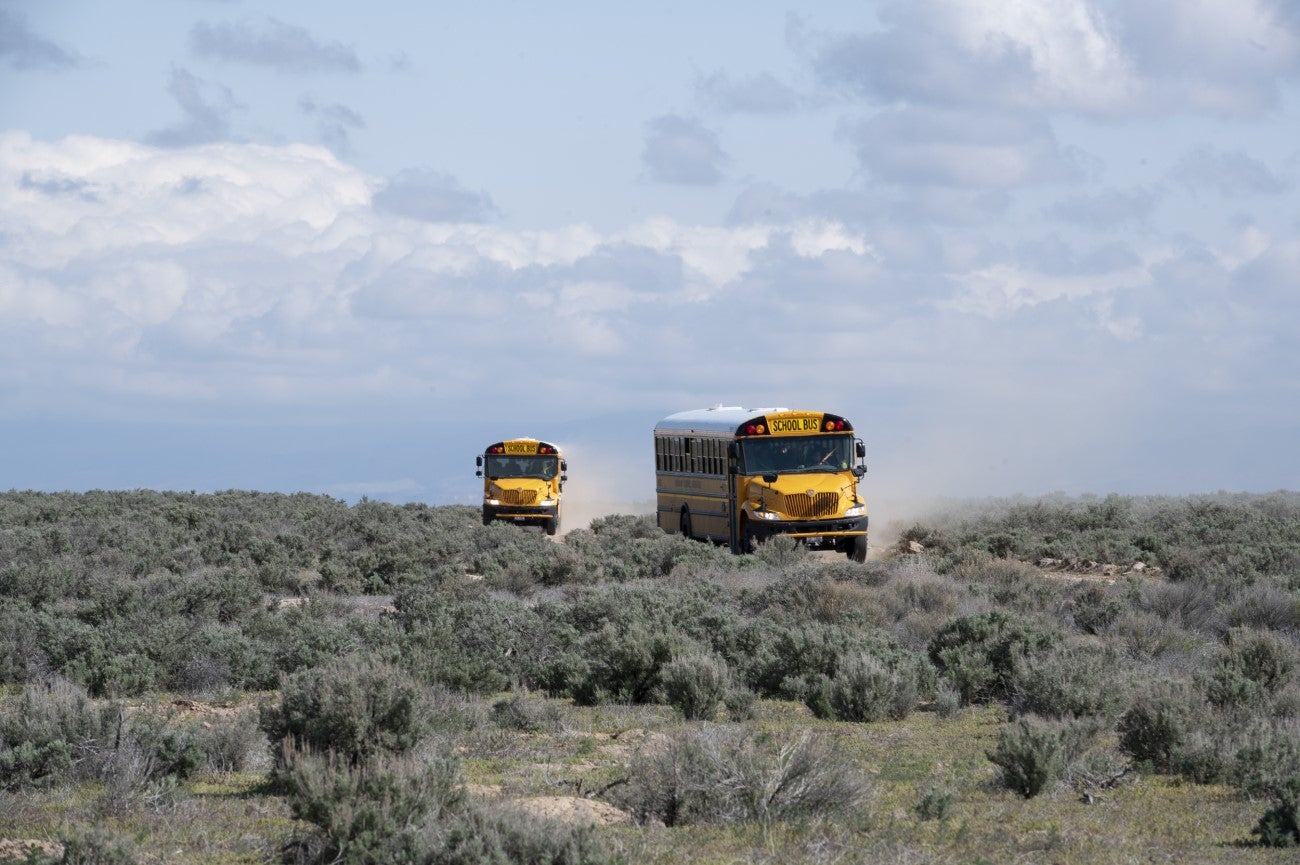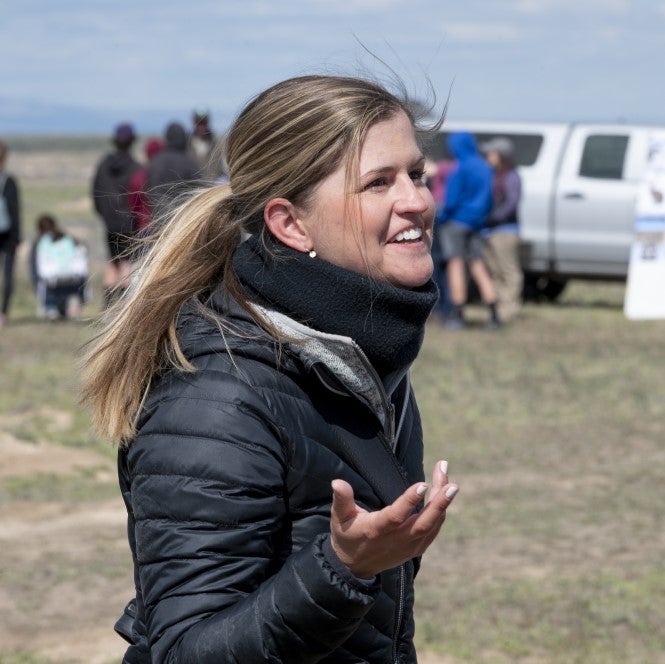
A bright yellow prairie schooner of a school bus bounces over the uneven terrain of the sagebrush steppe and comes to a halt. The door squeaks open, and out flock 180 Heritage Middle School seventh graders, their colorful clothes like exotic plumage against the dry landscape. From a field science station, Boise State alum Zoe Tinkle Duran (MS, biology, 2016) waves them in.
For nearly seven years, she has introduced Idaho youth to the real story of the sagebrush steppe and all of its levels. The sagebrush steppe is the biggest rangeland ecosystem in the country. It stretches across 165 million acres of the American West, including Idaho.
“When I was in graduate school at Boise State, my major advisor, Dr. Jen Forbey, and I started the Adopt-a-Scientist outreach program in 2015,” Tinkle Duran explained. “I serve as the ‘adopted’ scientist, where I do an in-class visit with the students to introduce myself and introduce the sagebrush steppe ecosystem.”

In the field, Tinkle Duran and Forbey combine forces with Boise State experts, the Idaho Rangeland Resources Commission, the Bureau of Land Management and the Idaho Army National Guard, and University of Idaho. Together, these educators show students to see a landscape through many different lenses.
From underground soil biology and chemistry, to the herbivores that eat the sagebrush, to the carnivores that prey on them, all the way to the drones-in-the-sky view, this team shows how science answers questions and reveals patterns and truths about the ecosystem we often take for granted.
Through this experience, students realize that they can be scientists, too.
“What always sticks out in my mind is how the students view ‘science’ and ‘scientists’ before and after the field trip experience,” Tinkle Duran said. “Before the experience, we ask the students ‘what is a scientist to you?’ and, invariably they will respond with: ‘white lab coat!’ ‘Bill Nye the Science Guy!’ After the field trip and the students meeting the diversity of representation of scientists there, they come away from the experience with a completely different response: ‘I could be a scientist!’”
Play GEM3 Adopt-a-Scientist Outreach
In this video, Zoe Tinkle Duran (Idaho Army National Guard Natural Resources Specialist) and Jennifer Forbey (Biology Professor at Boise State University) dsicuss the GEM3 Adopt a Science Outreach program. Closed captions are available and a text transcript is provided on in the Video Transcript section this page.
As the former natural resource specialist for the Idaho Army National Guard, and now the lead biologist and owner of Duran Environmental Consulting LLC., Tinkle Duran is dedicated to enlightening people about the value of the ecosystem.
“We like to be able to bring them to a real study site that real Idaho scientists are participating in to show them that they can be involved in it themselves,” Tinkle Duran said. “And on a more personal note, I feel like bringing the students into my world – the world of field research and the sagebrush steppe – gives me a renewed appreciation for what I do and how fortunate I am to do what I love for a living.”
The students’ visit took place on Bureau of Land Management land south of Boise in the Morley Nelson Snake River Birds of Prey National Conservation Area and Idaho National Guard Orchard Combat Training Center. Support for the Adopt-a-Scientist program comes from a National Science Foundation EPSCoR grant through Forbey’s lab and from the Idaho Army National Guard Environmental Management Office, in addition to the generous donation of time by the many professionals who participate in the field trip.
—By Brianne Phillips, Photos by John Kelly, Video by Matt Crook
Support Student Excellence
Become a scholarship donor to support future members of the Bronco Family.
Become a donor to support student excellence at Boise State.Video Transcript
(upbeat music)
[yellow school buses in distance drive across the sagebrush]
[Zoe Tinkle Duran. Idaho Army National Guard Natural Resources Specialist] We are at our field trip site this year. We have a field trip every year with a seventh grade class out of Heritage Middle School. And we come out and we like to be able to bring them out to a real study site that real Idaho scientists are participating in to show them that they can be right next to science happening, and they can be involved in it themselves.
[Students exit the bus and walk towards the field labs set up in the sagebrush]
[Tinkle Duran] When we asked students at the beginning of this experience, describe a scientist to me, it is Bill Nye the Science Guy, crazy white hair in a lab coat and mixing things and beakers. And by the end of this experience, we asked them the same question, and it becomes anyone can be a scientist. I could be a scientist, because by having all these collaborators do different stations, what they realize is that scientists come in all shapes and forms. And I hope that when they come out, they can have some resonation and they can feel represented by the real scientists that are here showing them fun things. And they can feel like that’s something that I could do, too, and it’s not just for geniuses or anything.
[Student complete science experiences using a variety of equipment, and interact with staff]
[Tinkle Duran] So this year, the theme was different lenses. How can you look at the landscape in different ways? So the first station was an underground lens. We wanted to look at soil chemistry, soil biology, the biota in the soil to talk about how then that influences vegetation.
[Students complete experiments with soil before running to the next station]
[Tinkle Duran] Then they go to the next station, which talks about herbivores and the relationship between herbivores and vegetation. So what type of vegetation needs to be available for both our native native Idaho wildlife, but also for livestock because we’re in open rangelands.
[Students view presentations about herbivores before moving to the next station]
[Tinkle Duran] Then they go from what eats the plants to what eats the things that eat the plants. And so then they go on to our wildlife station where we talk both about prey, but also what eats the prey and why we’re in the Morley Nelson Snake River Birds of Prey Area is because of those birds of prey.
[bird chirping as a bird of prey is removed from a crate and showed to the students]
[Tinkle Duran] Then we go on to the technology that we use to monitor all of these different aspects. And so we moved on to our GIS station which had some remote sensing. And so they can kind of get that sense from the soil, up to the raptors, and then how do we monitor it all.
[upbeat music plays as students interact with various technology tools]
[Jennifer Forbey, Biology Professor at Boise State University] Seventh graders are sort of at this stage that they’re either going to buy into thinking about our landscapes and sustainabilities and being those stewards or they’re not. And so I think they’re sort of at a sponge. I mean we looked at, we had a cow pie and we talked about larva in that cow pie and how they’re food resources and how they’re transforming from a larva into an insect. And these seventh graders are transforming into real adults that are going to have impacts on the decisions they make of these lands. So it’s important to connect with them and teach them what we do and why these landscapes are important at an early age.
[wind blowing as scene pans to an aerial view of the landscape]
[Tinkle Duran] I love Idaho’s landscapes. I think the sagebrush steppe desert is such an underrated ecosystem and such an underrated landscape, and it’s one of those if you’re driving by too fast, you’re going to miss how beautiful it is. And I think that’s why we have to bring the students out to actually get dirty and put their boots on the ground because the beautiful diversity of this landscape happens at this level, not at the drive by level. So I think understanding more about the complexity of the sagebrush steppe ecosystem is absolutely something that we can do out here in this field trip, and something that I really gravitated towards when I started as a seasonal field technician. But I just get to do it as my job now because it’s asking, I wonder why this does this, and I wonder if I could test this out. And that’s all seventh graders are doing all the time. So I think it’s actually a perfect inflection point in their education to grab on to that creativity and really start to hit people with STEM and say, this is something that you can do.
(upbeat music)
Supported by
NSF Idaho EPSCoR Program, the National Science Foundation under award numbers OIA-1757324 and OIE-1826801, the Idaho Army National Guard, the Bureau of Land Management, the Idaho Rangeland Resource Commission, 4H Americorps, Boise State University, and Heritage Middle School
